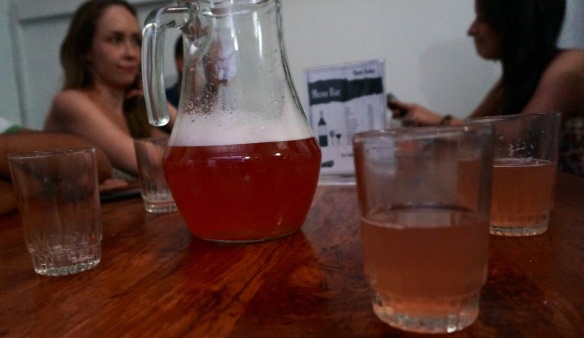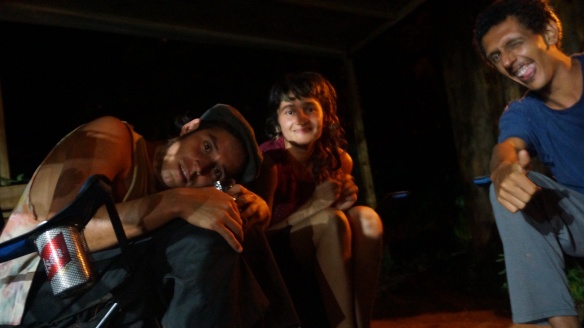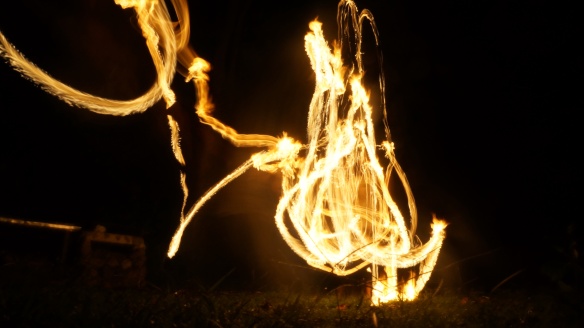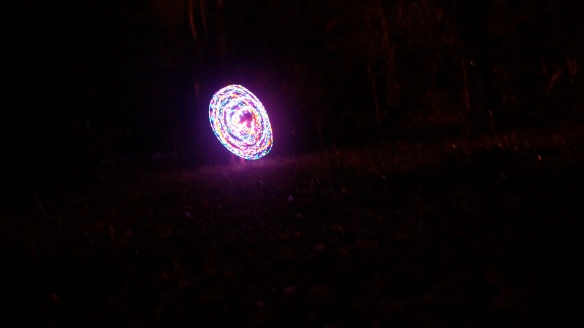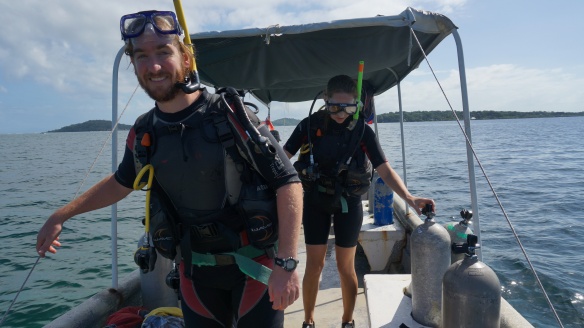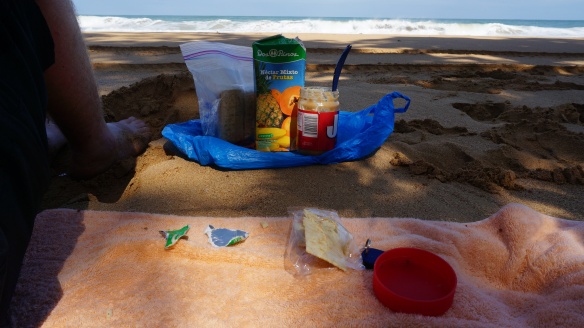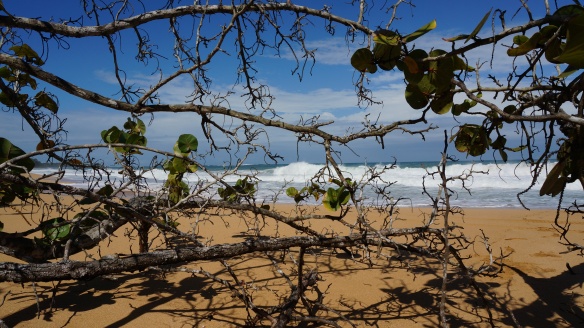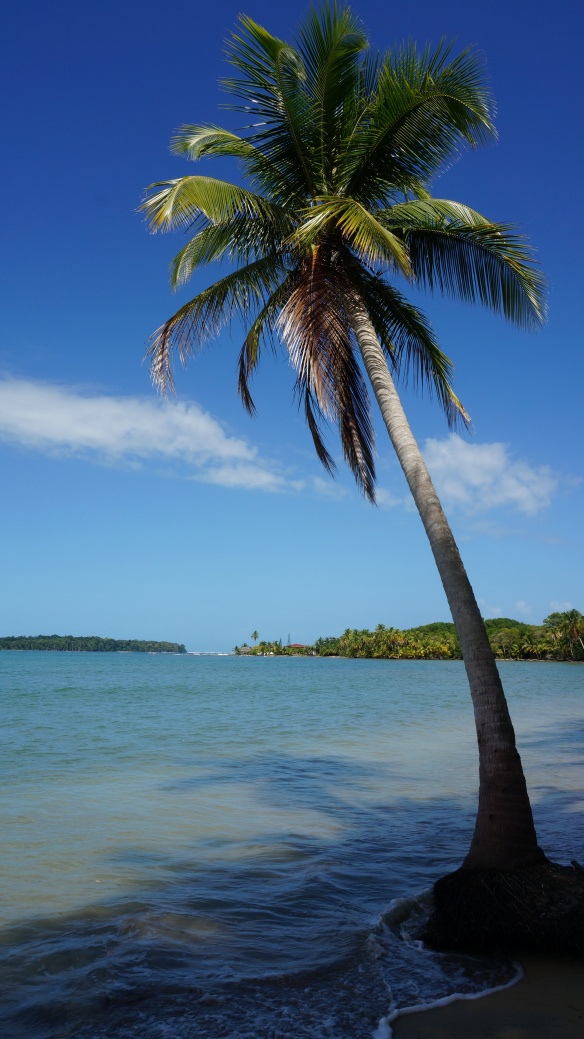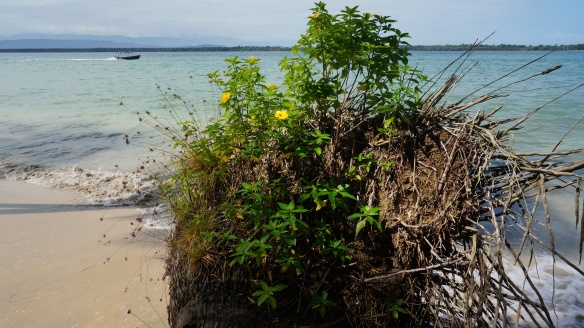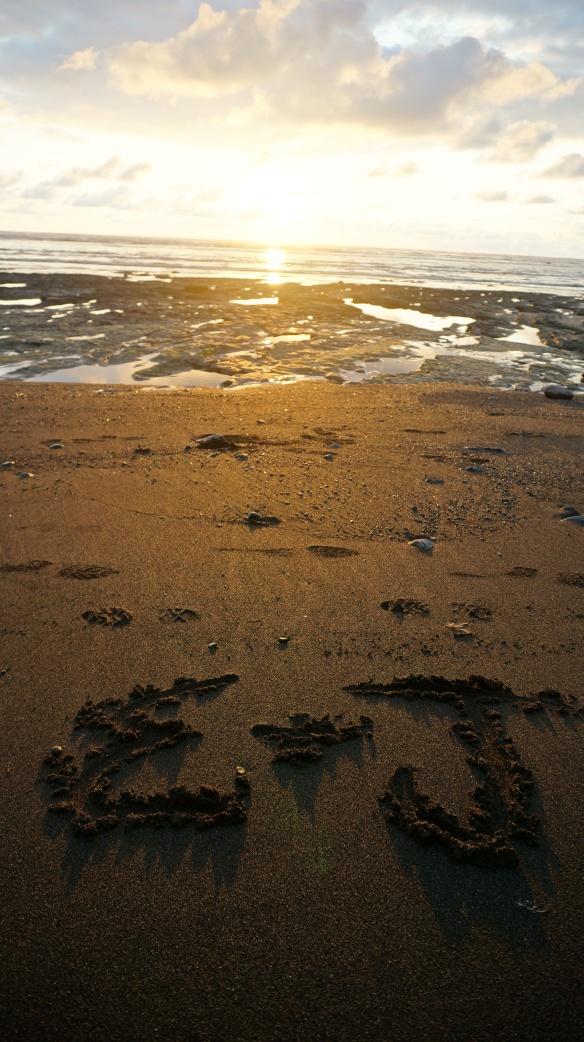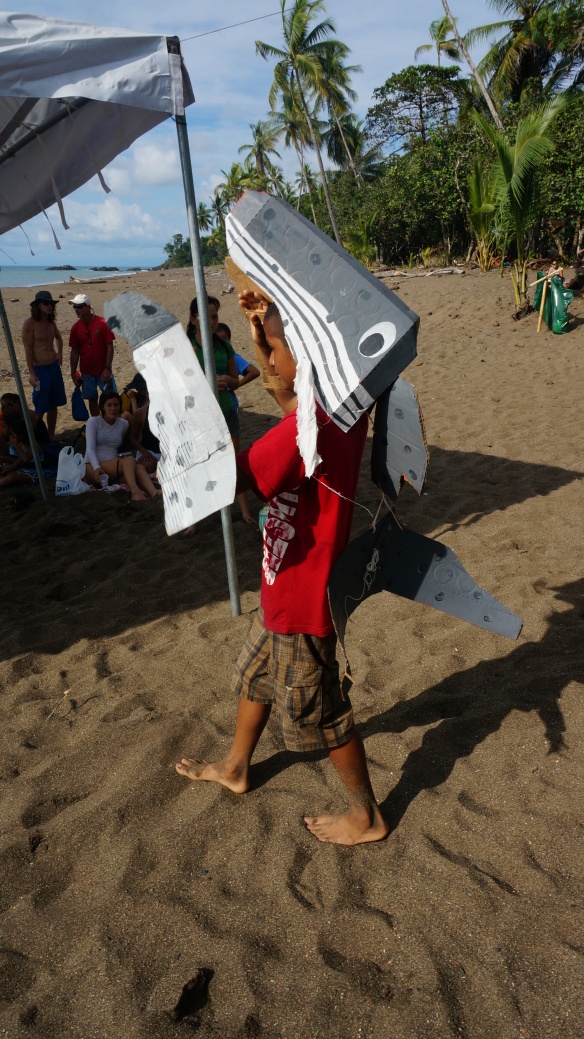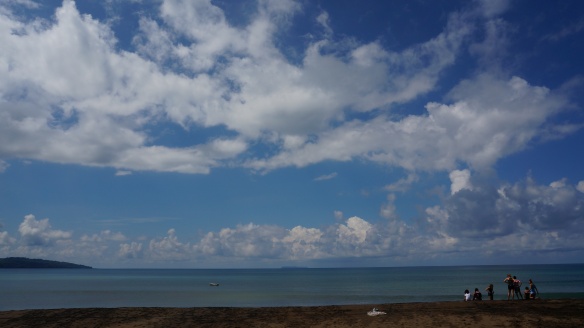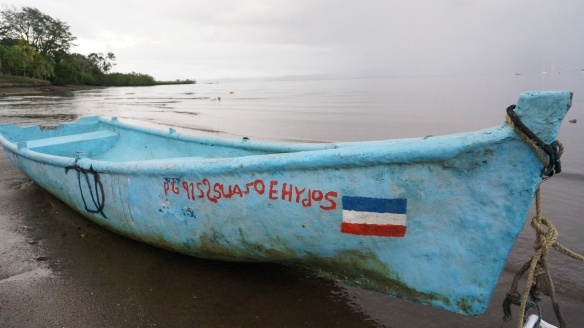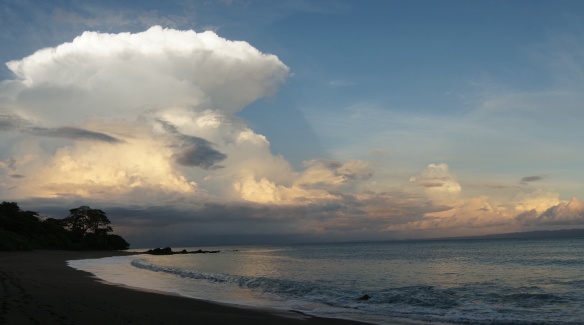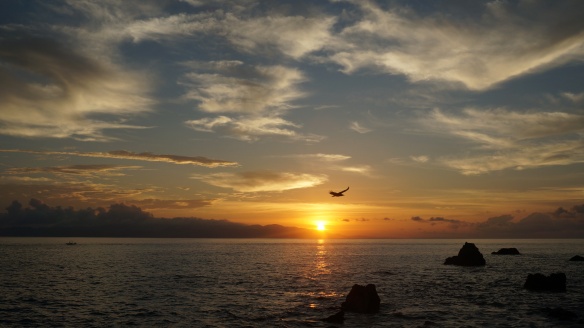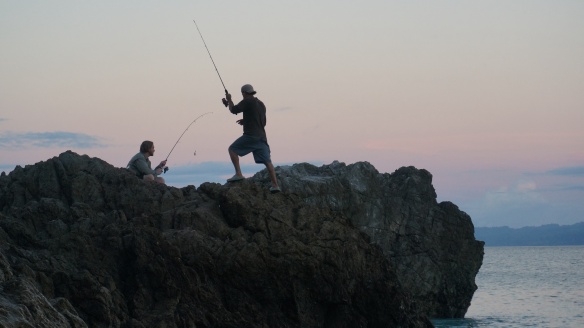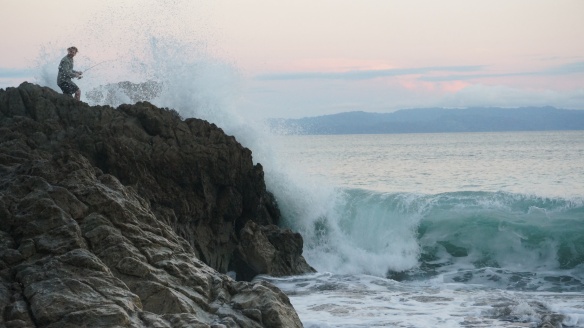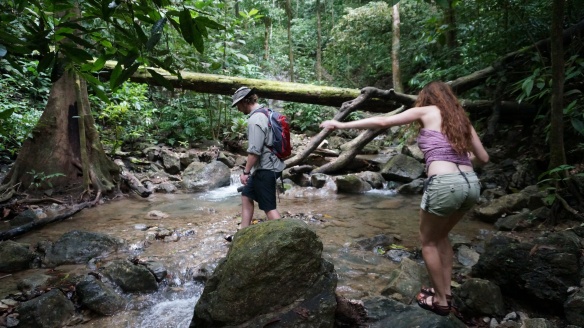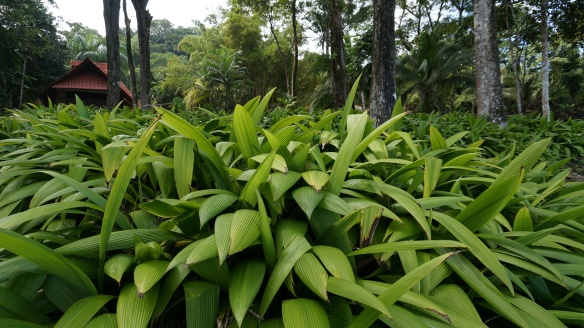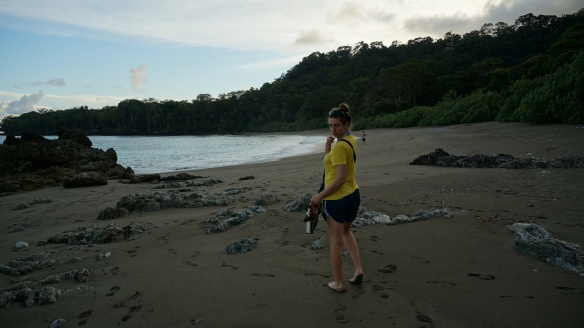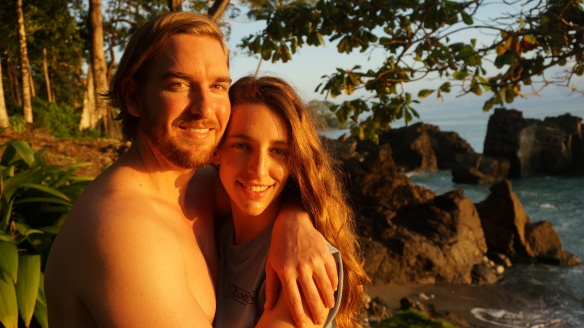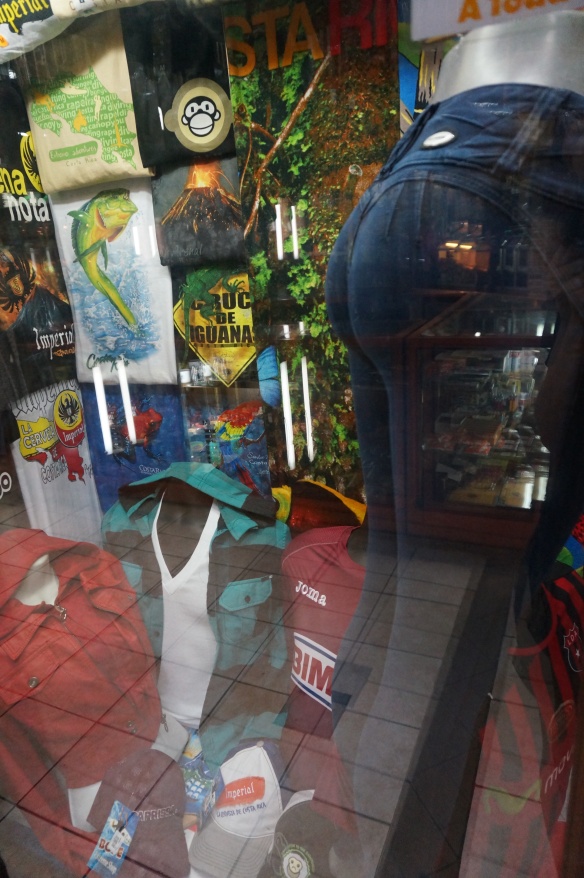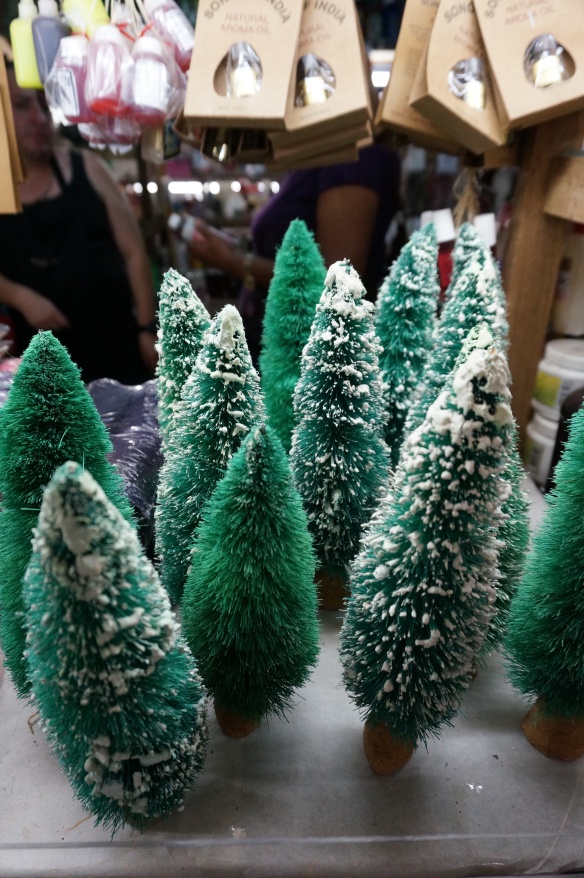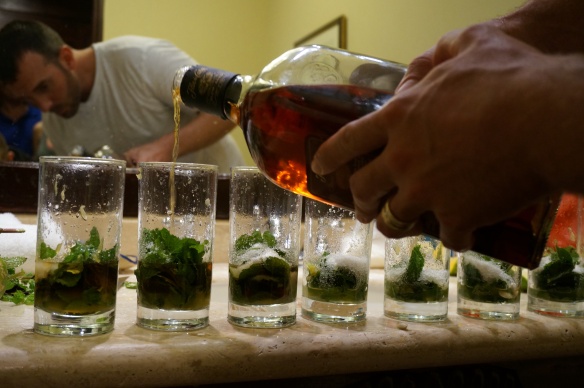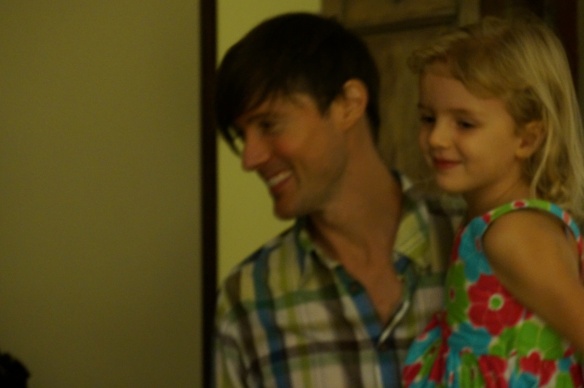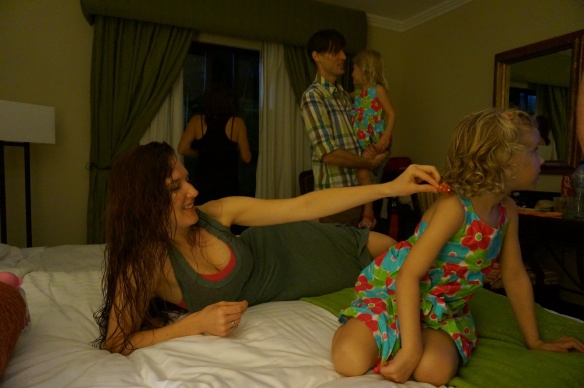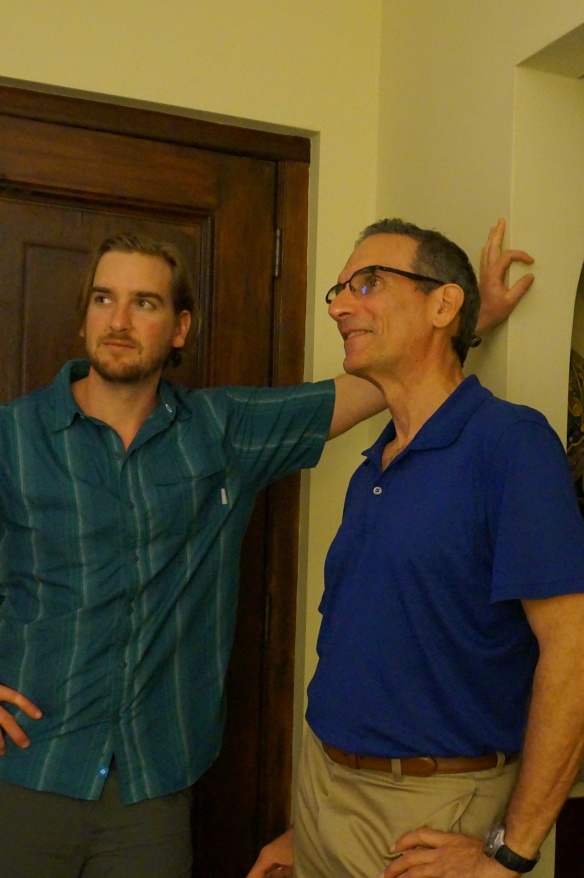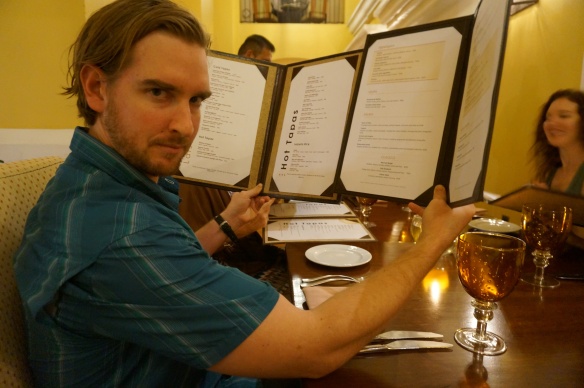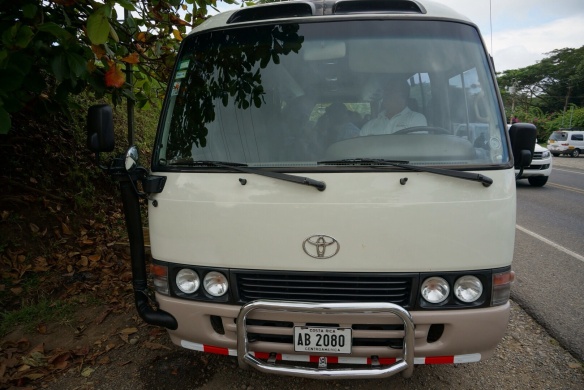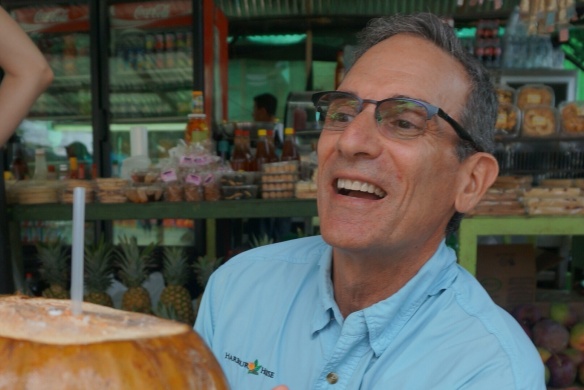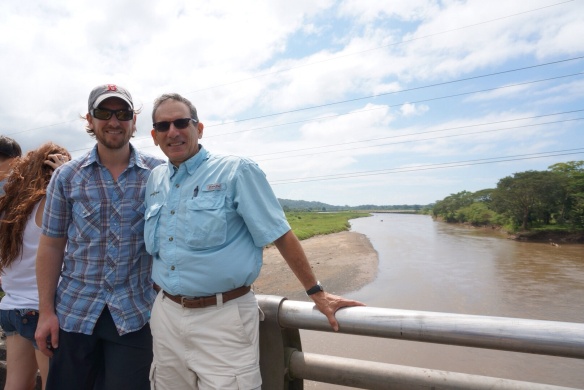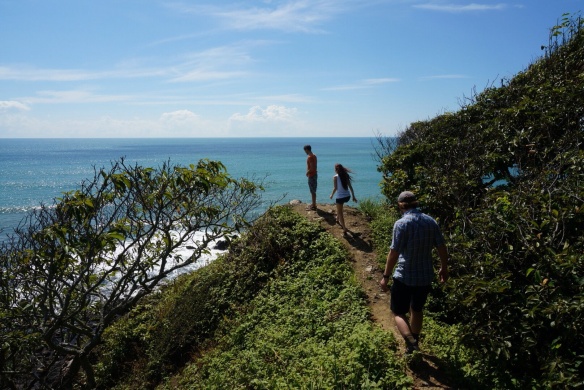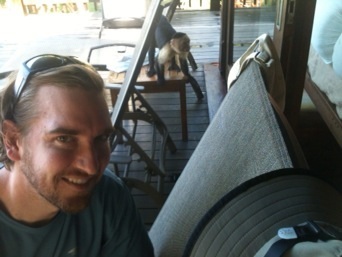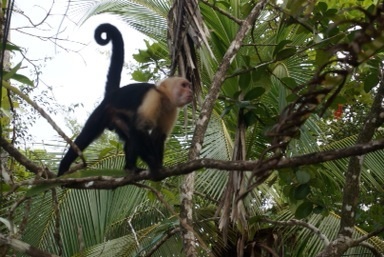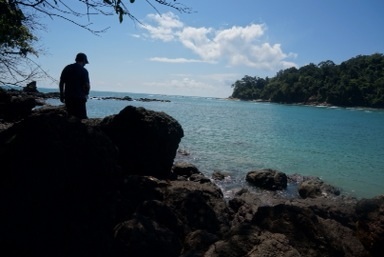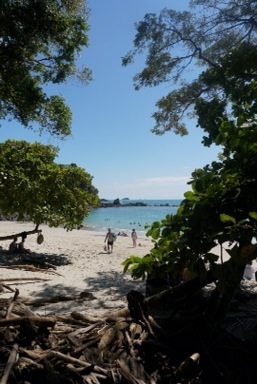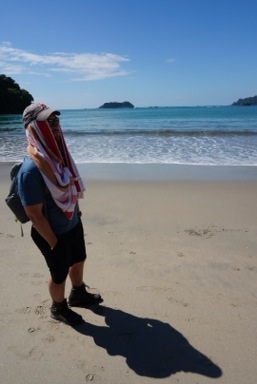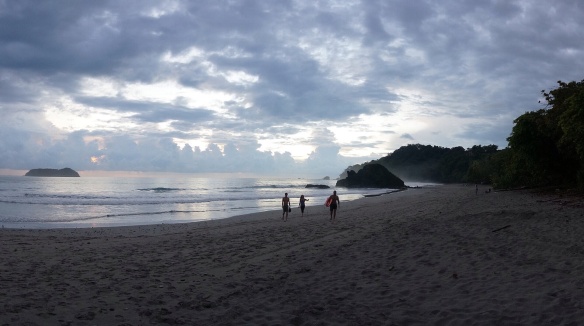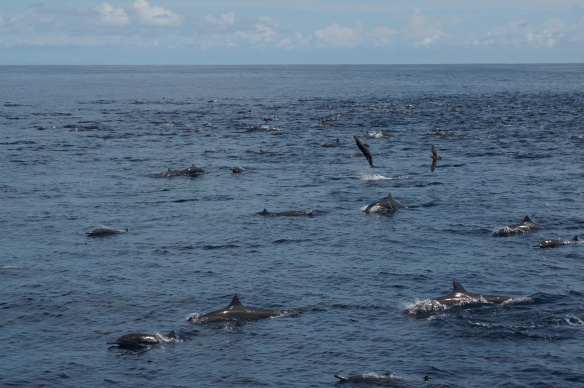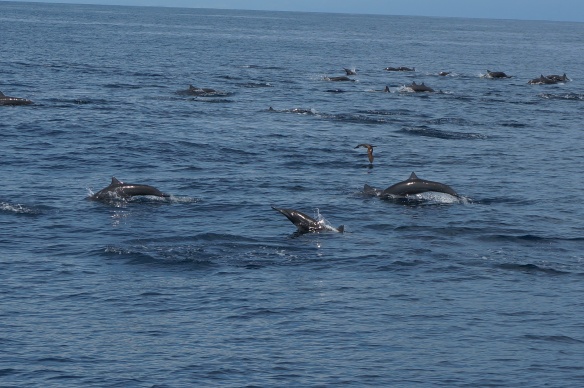One of the most spectacular things we ate while wwoofing at Al Norte Del Sur was a traditional curanto, which you can read about in our previous post. Almost everything we ate was cultivated on the farm and made from scratch. It is pretty amazing when a large family, with a restaurant, only has one relatively small refridgerator. That’s all they needed because the produce was just waiting to be picked and the dairy products were squeezed and cultured each day! There was fresh cheese, jam, hearty stews, eight varieties of potatoes and all sorts of delicious homemade breads, fried dough and empanadas. By the end of the month I think I was averaging about 10 rolls a day, which was totally inappropriate considering bending my arm to pick raspberries was hardly the ‘strenuous farm work’ that would necessitate the frantic carbo-loading mania which possessed me at each meal. Not only did Al Norte cook deliciouus food, they also employed a zero waste lifestyle on the farm which taught us alot about sustainability. No food (or water for that matter) was ever wasted. Between the humans, dogs, pigs and compost pile, every morsel was consumed. Needless to say, we were fed very well and, despite my increased risk of developing jam-onset diabetes, we ate happily.
The Most Epic Costa Rican Sunset
As spring and warmer weather is starting to return up north, I thought I would post this beachside sunset throw back from the beginning of our trip. This was in Manuel Antonio, Costa Rica. Enjoy!
Chilote Curanto: A Fire Pit Feast

 Aside from homemade cheese and jam, a curanto was the most distinctly chilote cuisine we were lucky enough to enjoy, several times. Nowadays, the people of Chiloé can cook a curanto in a large olla, or pot, on the stove. However, traditionally a curanto is cooked and eaten outside. The benefit of cooking a curanto in a pot is that you can save all the broth from the melange of ingredients, which is then ladled out and sipped on as a lovely addition to the meal. Some even say this special liquor is a type of aphrodisiac! The benefit of the traditional curanto is the rich, smoky flavor imparted by the firepit. We had the pleasure of learning about curantos from the family farm we wwoofed at, Al Norte Del Sur. Curantos can be an all day affair, requiring much preparation. As you can see from the pictures below, the result is well worth the effort! Stones are heated to blazing levels in the morning over a big fire. The stones provide the heat to cook the curanto so it is essential that they get very hot. Once the stones were ready, they piled on sacks of gigantic mussels and clams, freshly picked potatoes, fava and pea pods, chicken, pork belly and sausage. They covered the meat with gigantic leaves that grow all over the island. The leaves help to seal in the heat and also provide a platform to cook the final component of a curanto: milcau and pan de papas! Milcaus are like giant potato dumplings, made from flour, the starch extracted from shredded raw potatoes, and pork fat. Pan de papas consist of flour and freshly mashed potatoes, formed into a disk and stuffed with cheese. These delicious dumplings get spread over the steaming heap of food and covered with more leaves. The entire thing is then covered with a mountain of tall dried weeds and grasses to help seal in all the steam and heat. After about an hour, we would gather around the fire pit and, like kids on Christmas morning, watch wide-eyed as the family matriarch peeled away the grass and leaves revealing the feast beneath.
Aside from homemade cheese and jam, a curanto was the most distinctly chilote cuisine we were lucky enough to enjoy, several times. Nowadays, the people of Chiloé can cook a curanto in a large olla, or pot, on the stove. However, traditionally a curanto is cooked and eaten outside. The benefit of cooking a curanto in a pot is that you can save all the broth from the melange of ingredients, which is then ladled out and sipped on as a lovely addition to the meal. Some even say this special liquor is a type of aphrodisiac! The benefit of the traditional curanto is the rich, smoky flavor imparted by the firepit. We had the pleasure of learning about curantos from the family farm we wwoofed at, Al Norte Del Sur. Curantos can be an all day affair, requiring much preparation. As you can see from the pictures below, the result is well worth the effort! Stones are heated to blazing levels in the morning over a big fire. The stones provide the heat to cook the curanto so it is essential that they get very hot. Once the stones were ready, they piled on sacks of gigantic mussels and clams, freshly picked potatoes, fava and pea pods, chicken, pork belly and sausage. They covered the meat with gigantic leaves that grow all over the island. The leaves help to seal in the heat and also provide a platform to cook the final component of a curanto: milcau and pan de papas! Milcaus are like giant potato dumplings, made from flour, the starch extracted from shredded raw potatoes, and pork fat. Pan de papas consist of flour and freshly mashed potatoes, formed into a disk and stuffed with cheese. These delicious dumplings get spread over the steaming heap of food and covered with more leaves. The entire thing is then covered with a mountain of tall dried weeds and grasses to help seal in all the steam and heat. After about an hour, we would gather around the fire pit and, like kids on Christmas morning, watch wide-eyed as the family matriarch peeled away the grass and leaves revealing the feast beneath. 









 Traditionally, people gathered around the curanto to eat directly from the fire pit, but we filled our plates and ate the feast on the grass in the sun. Additionally, Al Norte spiced up the affair a bit more, serving up glasses of freshly harvested strawberry smoothies and a cocktail of homemade fermented apple cider called chicha, warmed and mixed with honey. We loved the taste of the chicha, a much more rustic flavor than the sweet Terremottos of Santiago! Since the family has a restaurant at the farm we were lucky to taste these curantos and cocktails several times during our month long stay. The restaurant patrons always left the feast happy, and so did we!
Traditionally, people gathered around the curanto to eat directly from the fire pit, but we filled our plates and ate the feast on the grass in the sun. Additionally, Al Norte spiced up the affair a bit more, serving up glasses of freshly harvested strawberry smoothies and a cocktail of homemade fermented apple cider called chicha, warmed and mixed with honey. We loved the taste of the chicha, a much more rustic flavor than the sweet Terremottos of Santiago! Since the family has a restaurant at the farm we were lucky to taste these curantos and cocktails several times during our month long stay. The restaurant patrons always left the feast happy, and so did we! 

Wwoofing on Chiloé

View of the entire Al Norte Del Sur Property from the top of the neighbor’s hill. The farm house and restaurant are on the left and the refugio where we slept is on the right.
We were enchanted by the island of Chiloé. I’ll forever think of it as the land of wood burning stoves, homemade cheese and jam, countless varieties of potatoes, ‘yes that is poop on your shoes’ and some of the warmest people we were lucky to meet. Chiloé is where we first milked a cow, ate sea algae and drank yerba maté; where the weak are separated from the wwoof.
Perusing the Wwoof Chile list of member farms is both exciting and intimidating. Exciting because each listing seems to describe a mini paradise which has the potential to be your new, temporary home. Intimidating because it seems almost impossible to know which farm to choose. Jordan and I knew we wanted to start to explore southern Chile, and had heard wonderful things about the island of Chiloé, so we were able to narrow our search. We emailed a family farm called Al Norte Del Sur and were excited to be invited to volunteer with them for the month of January.
To get down to Chiloé from Santiago, we took a Pullman overnight bus to Puerto Montt. We were pleasantly surprised when the bus flight attendant seved us box snacks for dinner and breakfast! Most long bus rides in Chile come fully equipped with TVs and flight attendants (for lack of a better description!) who serve drinks, snacks, and even tuck you into your gratis blanket at night! From the Puerto Montt bus station, we easily bought tickets to the city of Ancud, where the family would be picking us up. Currently, Chiloé is only accessible by boat and so all the busses actually drive right onto the ferry! There is much political debate regarding the construction of a bridge to connect Chiloé to the main land. A bridge might indeed boost the growing tourism business there, but many are against it, possibly for fear of losing the geographical and cultural independence instrinsic to the island. We saw penguins and sea lions swimming in the water on our way over, which helped get us super excited to explore this unique place.
Better than penguins, we were greeted by the cherub like chubby cheeks of the newest addition to the Al Norte family when we were picked up in Ancud. The semi-uncertainty of what our future tasks around the farm would be was laid to rest when I met this adorable baby because I figured I would be lucky to change his diapers for a month. Look at those cheeks!
The farm is about 20 scenic minutes from Ancud, on a windy road that hugs the bay. You can thank Jordan and I for the 5 newly painted signs, complete with logo, guiding your way there (probably our only adroit work addition, being so ‘green’ to farm work and all). We couldn’t have been happier to pull into the farm to see an incredible vista of the hilly terrain, a strawberry patch and a young farm pup named Weicha running around in front of their small family restaurant.
After meeting the family, we were given the day to explore the farm on our own. The 15 hectare homestead included stunning views of the bay from the upper pasture, as well as patches of forest, milk cows, sheep, goats, turkeys, chickens, ducks, dogs, and cats.
Another wwoofer was also volunteering on the farm for the month of January and he did a great job of posing with many of the farm animals for us.
He also taught us that in the UK the term pudding, actually refers to all types of desserts! That’s not confusing at all! The family cultivated numerous items including myriad vegetables, strawberries, raspberries, calafate berries, blackberries, grosella, apples, pears, and more.

Gigantic Garlic! It’s just regular old garlic, but apparently when the soil it is planted in is kept loose, it will grow this big!
We did a variety of tasks during our month on the farm, the most common tasks being berry picking and collecting or chopping firewood. Personally, I feel that I have become adept in the art of strawberry size classification, knowing instantly if a berry would be considered a ‘pequeño’ or ‘malo’ for jam, a ‘medio’ for serving in the restaurant, or a ‘grande rojo’, the cadillac of berries, for selling at the market in town once a week. Jordan’s already bulging muscles grew to an almost unsightly size after his wood chopping mastery. I was also lucky to get the chance to help out in the kitchen at the restaurant often and learned some pretty great recipes!
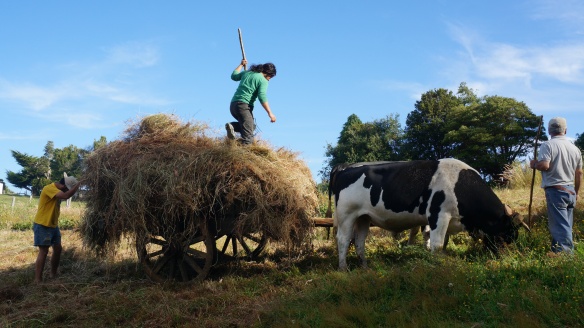
The only machines on the farm were a chain saw and a blender. Everything else was done using traditional, ancestral methods.
All the heat and most of the cooking at the farm was produced by several wood burning stoves throughout the house and restaurant. I had never lived in a place that utilized wood stoves so exclusively. The family was constantly checking the stoves to observe the strength of the fire. It was so pleasant coming in from a cold day and sitting next to the stove to warm up. When we emerged from our tent in our refugio in the mornings, I was always excited to see the smoke coming out of the chimneys because that meant that food was being made and hot water would be ready for tea.
There were many charming aspects of the farm life. While we were there, four chickens hatched little chicks. They were so small and delicate, constantly exploring but never more than a few inches from the mother hen. I’d be picking berries in the dense raspberry bushes and all of a sudden would hear the lightest little chirps as the hen and her brood passed by under the safe covering of the raspberry plants.
Also, while most of the sheep and the goats kept to themselves away from people, there was one house goat and house lamb, Rosita and Robin, respectively. Rosita was abandoned by her mother, possibly because she seamed weak at birth since it took her a little while to stand up. Robin has a lame leg. Thus both of the young outcasts became best friends and always hung out together near the house, waiting to receive their daily bottle of milk.
There was that time Weicha the farm pup followed a bunch of boy scouts all the way to the beach and thus was missing for a few days until one of the scouts returned her. We got a private performance of a traditional dance called the Cueca from the oldest granddaughter of the family, attended a local festival called a ‘Costumbrista,’ and saw the most incredible stars at night from our rustic refugio.
The best part by far of our wwoofing experience was being fully immersed in the family who generously hosted us. Our Spanish improved, we learned many new things about farming and sustainability, and the warmth and patience of our new friends made our stay at Al Norte Del Sur unforgettable.
Santiago, Chile: Terremottos
The second day in our Santiago Hostel, Hostal Providencia, we noticed a sign up sheet for free terre mottos. Having taken a tour of the city the day before we had been educated as to the popularity and the strength of this drink whose name translates to ‘earthquake.’ Free drinks at a hostel, you ask? Yes, there were and yes, we signed up immediately.
As we approached the patio for our free drinks that night we were welcomed by the sound of a gentle guitar and singing. While many people were seated at the picnic tables chatting, two Brazilian guys were playing the guitar and singing Brazilian songs. We had been sitting for only a minute or two with our beverages before the musicians welcomed us into the conversation. It turned out that almost the entire crowd was Brazilian! We had been drinking for only a pitcher or two until another Brazilleno arrived with a bag of traditional instruments, which he handed out with no mind to skill or comfort level. As the terre mottos sunk in, I didn’t know if I was in Santiago or São Paulo, all I cared about was refilling my cup when the next pitcher arrived and making sure that the washboard-like ‘jeca jeca’ (or something like that) I was playing was on beat to the now high decibel raucous rhythm surrounding us. It was the kind of music you would definitely want to be contributing to as opposed to listening to while trying to sleep in your hostel bed. I looked over and saw Jordan shaking a gourd draped with beads, and loving every second of it. It was a fantastic night and best of all, we met our new group of friends who we enjoyed Santiago with for the rest of the week!
Want to ‘feel the earthquake’? Here is the recipe:
Room temperature bottle of white wine
1/4 oz Fernet
1 oz grenadine
Pineapple Ice Cream
Mix all ingredients in a pitcher, stir to dissolve ice cream, taste, add white wine as needed. Take caution as this is quite easy to drink!
Artists in Costa Rica
The people we’ve met on the road have amazed and invigorated us by how open and friendly they are. Is it because staying at hostels or volunteer programs are inherently filled with other people looking to experience new things and meet new people? Is it because we ourselves are more open as we take this adventure around the world? Or is it just that in our previous home of Boston we just didn’t have the time or impetus to be meeting new people all the time? Whatever the reason, we feel so lucky to continue meeting top quality new friends everywhere we go.
A few folks that left a particular impression on us were three artists from Costa Rica. We met them while volunteering at the turtle camp with the Corcovado Foundation. They volunteered their time and performances to entertain the kids and other guests during the event. Having watched their performances we were excited to meet these creative people. That night, before we even exchanged any real words, one of the artists approached us with an incense stick and offered it to us ‘para protecion.’ We agreed and were treated to a cathartic treatment in which he captured a billow of smoke and directed it to our hearts and our heads with a confident and creative flair. It was one of those unexpected experiences that in the moment, you just don’t question. The incense ritual, which was routine for him but new for us, relaxed our bodies instantly. The act felt very intimate and from there we felt welcomed and comfortable to communicate with these interesting people. We spoke little Spanish, they spoke little English, but by virtue of their overly animated demeanors we were able to communicate, make jokes and enjoy the amazing Central and South American music they had queued up on their phones. Their dedication to their craft and general passion for life was always apparent as we talked. They were serious about being clowns because they lived their art. We saw them wake up and juggle, they played with the children between performances and afterwards retreated to critique the show. They were offered a hotel room but opted to stay with us at the turtle camp because they would rather sleep in hammocks and get to know the volunteers. Their skill and desire to connect with people left us with a newfound respect for clowns. They were an impressive bunch and we are glad to have met them!
Two of the artists were unable to finish their performance at the festival due to the weather so those of us at the turtle camp were able to enjoy a private performance of fire and light juggling. Here are some pictures from their performances:
Bocas Del Toro, Panama
Once again, we woke up at 4AM and girded our loins for the epic day of travel ahead of us. We were happy to have one of our new friends from the turtle camp, Charles, joining us as we made out way to Bocas del Toro Panama. We stumbled half asleep out to the road to catch the first ‘bus.’ There ended up being far more people than anticipated and so another car came. Jordan and I got a seat in the mini van type vehicle and others were sitting in a pickup truck with benches in the back covered by a makeshift roof. As the cars continued to pick up more and more people on the way to our first stop at Ríncon, a few guys had to sit on top of the make shift roof for what must have been a harrowing 45 minute journey – pura vida style! Our schedule for the day included 4 busses, 2 taxis, a border crossing on foot and a boat. Shockingly, we actually made it to each destination about 5-10 minutes prior to the departure of our next mode of transport. It was like a travelers solar eclipse, exceptional and beautiful, but still uncomfortable if you look at it closely.
We got through the border with relative ease, meaning we only sweated out half our body weight while waiting in the line to get a stamp to exit Costa Rica and then another line to get a stamp to enter Panama. We crossed the border at Paso Canoas which meant we needed to get to David and then from David to Almirante where we needed to catch the last boat to isla Colón by 6:30pm. The bus ride from David to Almirante crosses over a mountain range to get to the caribbean side. The terrain was stunning. There were endless mountain peaks in the distance covered in a variety of greens with a blue and sunny sky in the background. The ride itself was ok. We each had a relatively comfy seat and the loud beats of the Latin American radio station helped distract me from the way the bus sped around harrowing curves dangerously close to steep cliffs. Our friend Charles struck up a conversation with the woman next to him who, when told that he had been volunteering to preserve sea turtles, responded by telling him how delicious their eggs are.
We made it to Almirante with seconds to spare to catch the last boat. We stepped off the bus, already feeling a sense of urgency meet a group of Panamanians yelling for us to ‘hurry, the boat is leaving, hurry hurry.’ We hustled to follow them, threw our backpacks on the boat, squeezed in a bit of haggling so as not to be totally ripped off for this boat ride and were on our way across the sea. The boat ride was 45 minutes on calm water. I’m pretty sure the moon was full, if not almost there, and it lit up the water. It was beautiful and I couldn’t help but hum ‘dancin’ in the moonlight.’ Water occasionally splashed in the sides of the boat and bits of phosphorescence actually splashed in Jordan’s lap!
Jordan and I got ourselves a private room at Hosteluego, which was only a couple dollars more than each of us getting a dorm bed. The hostel was clean and comfortable. It turned out that Lasse, our friend from the turtle camp was also staying there. Also, Cristina, another girl who had volunteered at the turtle camp, was working reception in the mornings at the hostel in exchange for a free dorm bed. We took note of this economical trade as something we would try to do in the future.
The downtown area of Isla Colon in Bocas is basically a spring break style backpacker hub with cheap beers available everywhere and ample opportunities to drink all day long. This isn’t Jordan and my scene but it was fun to indulge here and there. The main goal of being there for us was to get our Scuba open water certification. Jordan, having much more ocean experience than me, really wanted to get certified and Panama is one of the cheapest places to do it, we were told. I never in my life thought I would go scuba diving but there I was, right next to Jordan, signing up.
We went for a three day certification course which included 2 confined dives and 4 open water dives at a place called La Buga. Our instructor Leo was a laid back and patient Panamanian guy who always gave us a fist bump and a surfers wave underwater if we completed a test correctly. The two ‘confined water’ dives actually just took place right in the ocean but just off of the docks. The scuba regulators, which you put in your mouth to breathe from, supply a steady and reassuring flow of air. That reassurance, along with the high quality goggles allowed me to stay relatively calm. We had to learn how to set up and test our equipment, and then we had to be able to perform many tests under water such as swimming without our goggles and controlling our buoyancy. The open water dives were each about 45 minutes long. I wavered between controlled panic and intrigued curiosity.
Only once did I really start to panic and thus hyperventilate and cry a little. No one knew that though, until now I guess. I realized crying and panicking was stupid because I would just lose visibility and run out of oxygen. Feeling like a fish out of water I was constantly making sure I was close to the instructor, trying to keep my childhood infection riddled ears equalized to the underwater pressure, and of course always taking deep steady breaths, the most important rule of scuba!
I’ve always heard that its ok to pee in a wetsuit and that actually, peeing can help you stay warm. I learned that wet suits, being so tight, actually keep a thin, insulated layer of water between your skin and the suit. The body quickly warms that thin layer of water and you stay warm. I tried to avoid peeing for as long as I could but eventually you just gotta go. As I gave in I could feel the hot urine enveloping my torso and legs. I quickly realized that now my insulated layer of liquid was being replaced by my own pee. I wondered, how quickly does that layer recycle itself? How long will I be surrounded by my own pee? When we ascend and get on the boat and remove our wet suits, will a puddle of urine form around my feet? How long have we been down here? How much oxygen do I have left? Is that eel poisonous? In the midst of a full fledged panic attack, I wondered, are my teary eyes deceiving me? Is Leo now all of a sudden holding a spear? I floated there, fighting an internal battle, watching Leo spear a lion fish through the gut in a swirl of billowy fins, it struggled for a bit then gave in to its fate. I too gave in, I was under water, I was not drowning, that fish is dead, I’m ok. If the whole pee thing didn’t work out up on the surface, I figured it wouldn’t be the first time or the last time I would pee in public. Pura Vida, wait we’re not in Costa Rica anymore…
Each dive we took got a little easier, and I will definitely try it again. Jordan loved every minute of it and I also extorted him into agreeing to take Tango lessons in Argentina if I agreed to do Scuba, so all in all everyone was happy and all was well. Our Scuba training kept us in the downtown party area for several days and so we obviously indulged in the $.75 happy hour beers at our neighboring hostel. After several nights of cheap drinking however, we were ready to get out of town and see more of the beautiful beaches Bocas has to offer. We found a great campsite which offered a raised wooden platform and roof for pitching tents for $3 a night. From there we spent two days on Playa Bluff and one day on Starfish beach. Both beaches were on opposite sides of the island and offered completely different but equally amazing experiences.
The first day at Bluff beach we picnicked on the most incredibly smooth, clay like sand. It was the color of sawdust and you could not find a rock or a shell for miles. There were also huge trees leaning over the sand providing cool shade, perfect for our picnic. This beach was on the eastern side of the island, and the surf was huge. Waves were crashing, one after the next, creating long tunnels that crashed with 40 foot spray. The currents were clearly going in all different directions so this was not an ideal surfing spot and certainly not safe for swimming. We enjoyed our own private stretch of beach and then the next day indulged in a beer from a little thatched roof bar-hut a little ways south from our private spot.
On the western side of the island, Starfish beach presented us with ultra calm and crystal clear water with white, soft sand. Even when we went into the water up to our chest you could still see your feet perfectly clear standing on the sand. Starfish beach got its name due to the uncommonly high number of starfish that congregate in the shallow waters. They ranged from deep red to bright orange and actually moved surprisingly fast along the sand. Jordan and I purchased a few $1 beers throughout the day which gave us a pass to lay in the hammocks and beach chairs of another thatched roof bar right by the water. We also ordered a big plate of crispy fried plantains. The day couldn’t have gone any better.
We were happy in Bocas, partying a bit, lounging on beautiful beaches and exploring a new underwater world. We were happy to be there with the friends we had made in Costa Rica because it was nice to celebrate christmas with familiar faces. After a week and a half though we were ready to move on, out of vacationland and on to our next adventure. We were off to Panama City to catch our flight south to Chile!
We were bummed that we missed exploring all the other islands in Bocas. Anyone ever been to one of them? Anyone have any fun snorkeling or Scuba stories out there?
Volunteering Inside Corcovado National Park
Our stint as volunteers with the Corcovado Foundation also included four nights as volunteers inside Corcovado National Park. Volunteering inside the park is a relatively new and untested opportunity offered by the foundation and Rob, the director, warned us that our duties might be mainly cleaning the ranger station as opposed to helping with any trail work. We figured we would give it a go anyway since we both wanted to get inside the park and we weren’t afraid of a little cleaning. We woke up very early on Tuesday morning so that one of the research assistants could drive us to the neighboring town of Agujitas where we would be catching a ride on a boat that the hotels use to send tourists over to the park. Other than the boat option, the only other ways to get into the Sirena Ranger Station are to walk or take a tiny 6 passenger plane.
Our boat ride that morning was beautiful. The boats pull right up to the shore line on the beach where you walk into the water and onto the boat. No docks in sight! We motored past Isla del Caño and saw dolphins swimming nearby the boat. When we arrived at the park entry (aka a break in the trees at an unmarked stretch of beach), we waded onto shore, put our shoes on and were told by the hotel employee that the Sirena Ranger station (our arranged destination) was just straight ahead. Not knowing where we were going or who we were supposed to find when we got there, we headed off into the woods. Multiple turns, and a few stream crossings later we arrived at a clearing that led to the ranger station. This 800 meter grassy clearing functioned as the landing strip for the small planes bringing people in and out of the park as well as a welcome mat for the brave hikers who make the 8 hour hike into the park from the Carate. We were pleased to see that the Sirena station was a simple, clean and well kept campsite. We pitched out tent in one of the camping areas which consisted of a raised wooden platform covered by a roof. With some difficulty we figured out who the ranger was, checked in and were told to never leave the campsite after 6PM, never be late for a meal and always tell him when we were leaving, where we were going and when we came back. After that drill sergeant-like introduction we figured we would have a schedule of tasks laid out for us to do each day, but this was absolutely not the case. We gathered that sweeping the station was to be a daily activity and other than that we basically hung around the kitchen trying to make ourselves useful. We basically created our own schedule of sweeping in the morning and cleaning the dishes after breakfast, lunch and dinner. In exchange for this work, and the $25 a day we paid to be a volunteer, we got free transport in and out of the park, three hot meals a day prepared by the station cook (which normally costs campers $70 a day) and plenty of time to get in two great hikes a day! We felt that it was a great deal.
We ended up exploring all the trails that lead out of the Sirena station except for one which the ranger told us was lacking all trail markers, had lots of downed trees blocking the trail and on which two hikers recently got lost on and had to spend the night in the forest alone. We were confused as to why we seemed to be the only ones he told about this hazardous trail but figured we wouldn’t push our luck so we avoided it. The trails are all generally safe during the day as long as you stay on them and watch where you are stepping as to not disturb any poisonous snakes. We never encountered any snakes but many groups walking with guides saw several poisonous varieties just steps from the trails. We were also bummed to not see any poison dart frogs but we really can’t complain. Over the few days we saw all types of huge iguanas and lizards, bull sharks, a gigantic Tapir, agouti, toucans, macaws, squirrel monkeys (titis), spider monkeys, howler monkeys, wild pigs, white tailed deer, crocodiles, caimans and some epically large and old trees. Instructions at the ranger station advise you to carry a walking stick which can double as a defensive device should you encounter a jaguar or a cougar on the trails. Normally these creatures don’t come out during the day, but if they do you are instructed to stand you ground, look as big as possible, and stare the cat down in the eye. If you run from one of the big cats, their instincts tell them that you are weaker than them and they should attack you because you are probably dinner. On our first hike I have to admit I was pretty nervous. Not only watching out for snakes and trying to avoid getting bitten by leaf cutter ants, but also for a potential large animal encounter. After about 5 minutes into the first hike two branches snapped and fell to the ground near us, rustling the dense forest around us. Two monkeys had a little tussle and broke a few branches, a common occurrence as we discovered. However, I immediately was convinced that the noise was the sound of a jaguar charging us and what did I do? I started running away down the trail without a walking stick. Perfect. Jordan scolded me and I tried to keep my jitters on lock from then on.
Our first hike took us to what turned out to be our favorite spot. The Rio Claro trail leads hikers to a beautiful fresh water swimming hole. No alligators or snakes were in sight and we tried to go there every afternoon to cool off in the water for a while. Often monkeys would come to the trees at the edge of the water and one day we even saw a pigmy kingfisher bird skirting across the water. Each trail offered the hiker a different experience, from dense forest to skirting the sandy coastline. I was fascinated by the variety of fungi and mushrooms growing on the rotting logs all around the trails. Many of the fungi were delicate, tiny and a vibrant white, kind of like tropical snowflakes. The density of the tree tops and the intricacies of the gargantuan tree trunks marked the trails of primary forest and provided a shady calm environment in which you could hear all sorts of mysterious sounds. We tried to stay as quiet as possible on our hikes and several times found ourselves only feet away from monkeys and other wildlife. Other than the Jurassic sized mosquito bites we suffered, we experienced some incredible nature, met several wonderful people, and had a great time. We even walked down to the end of the landing strip a couple nights to take in the sunset. It was amazing to sit there, in the middle of the wilderness, watching the gold and amber light glistening off the sheets of volcanic rock which stretch from the sand into the water.
Feeling in touch with nature and at peace, we packed up our backpacks and made our way back to the section of beach where we would be catching our boat back to the turtle camp. When we arrived i noticed that the water was much choppier than it had been on our way in. No one else seemed to notice and the boats arrived just as before, pulling n close to the shoreline. Only this time the 2 man crew had to hold the boat steady as the waves crashed and the passengers ran and hopped into the boat before the next wave crashed and jolted the tiny boat. We all made it in and stuffed our bags in the front and off we went crashing into the waves. My nature induced calmness and serenity were immediately knocked out of me as we embarked on the most turbulent, white knuckledboat rides i’ve ever had. Jordan and I were sitting in the front row and were jolted up and down by 2-3 feet ever other second. I sat there, trying not to see the waves swelling on our left side, or the 30 foot spray from the waves crashing into the jagged rocks on our right side. After the longest hour and a half ever, I wondered where I could get either a shot of whiskey or perhaps a fresh pair of underwear as quickly as possible.
When we finally made it back to turtle camp, we enjoyed the program’s farewell barbecue and said goodbye to our new friends. We started making preparations for our next stop on the journey, the archipelago Bocas del Toro in Panama!
Has anyone else been to Corcovado or explored the other ranger stations? We would love to hear about your experience! Or, has anyone out there ever encountered a potentially dangerous creature while hiking? How did you react?
Volunteering in Drake Bay, Costa Rica
As we prepared to say goodbye to Beth and Travis, Jordan and I also prepared to make our first solo trip of our backpacking adventure. We were about to volunteer with the Corcovado Foundation for about 10 days. We left Cabo by taxi and caught a school bus turned public bus to La Palma. From there, we caught a collectivo (basically a mini bus or big taxi) to El Progresso, a town in Drakes Bay, Costa Rica. We noticed people on the bus buying clear plastic bags of what looked like cream which they were drinking during the ride. We hesitated buying one thinking that sucking down a bag of cream would not make us feel good on such a hot day. We later discovered that the bags contain a delicious Tico style ice cream and we were kicking ourselves for not buying it at every chance. While sweltering on the black leather seats of the last car, we enjoyed the view of the lush landscapes and wondered what our next adventure would be like.
We finally arrived at a small structure, typical of many in Costa Rica, concrete/wood walls with a tin roof. The director of the turtle program met us out front. Rob is a friendly British expat who started off as a volunteer in the program several years back and now lives in Costa Rica full time directing the conservation project. In addition to Rob, the ‘turtle camp’ housed the other research assistants and some volunteers, though most of the volunteers live with home-stay families in the neighborhood. The camp was where everyone hung out in the evenings or during down time. For the first 5 nights we stayed in the ‘VIP suite’ which was a private shed consisting of 4 wooden walls and a bunk bed. While in our VIP shed, we could hear the rustling of chickens and a rooster as they scavenged for grubs and bugs to eat. We now know that it is a myth that roosters will crow at the sunrise. Interesting fact, roosters actually crow all the time, particularly at 3AM and curiously, their crows can resemble the sound of Eeyore crying like an old lady. Other than the dorm area, the turtle camp was pretty much an open air structure with a bunch of hammocks available.
In addition to the smattering of scarlet macaws, toucans, monkeys and the assemblage of poultry, the camp was also the hangout spot of many of the local dogs. The dogs were not strays, but no one fences in their pups so they would all congregate on the concrete floor of the camp. Many of them were cute, all of them could have used a bath and probably some frontline plus. There was one particularly mangy mutt named Kaiser. Kaiser was so ugly and pathetic looking that you couldn’t help but loving him instantly. His musk warned you of his presence long before his actual arrival. He was born with a serious underbite which meant that his lower fangs were always sticking up, like an extreme bulldog grin. As a puppy, he suffered from a machete accident and thus now walks with a mangled frankenstein limp. All he wanted was a little love and a few stolen bites from the compost bin. Despite his injured leg he was able to run around with the other dogs and even followed us all the way to the beach one day!
The staff and the other volunteers we met were wonderful people. Two people we met had actually been living in Boston! Others were from Spain, Germany, Canada, France and other parts of the US. We had worried that arriving for the last 10 days of the project might make it hard to get involved and connect with everyone, but that was not the case at all. We arrived right before the annual turtle festival, sort of a grand finale of the program. With such a large undertaking to prepare for, there was plenty of work to do. Jordan and I helped build a bathroom, hung signs and at one point even harvested coconuts for the water when the coolers were empty. One big project involved jerry rigging 6 hoses together so that fresh water could trickle out at the beach. A family who lived closest agreed to provide the water from their spigot. The hose line snaked through the forest and even over a drawstring bridge. Not to mention that everything used for the festival had to be hauled over said drawstring bridge which dangled a bit too shakily over the crocodile infested river below. It was fun walking over that bridge at night while holding a box so that you only had one hand to hold onto the ropes, yeah that was the best! We learned that almost anything is possible at the beach when you have a machete and some bamboo. Need a table? Want to build a stage on an isolated beach? need a tool to knock coconuts off a coconut tree? with a machete, bamboo and a ‘pura vida,’ no problem. There were a million and one jobs to do, but everything came together for a wonderful festival. The festival enabled local people to sell food and other goods to tourists and community members, it allowed the kids from the education program to present their skits on sustainability, and the timing worked out that the eggs in the last protected nest hatched and could be released to the sea in front of all the festival goers. It was amazing enjoying the two day festival and watching the sunset on the beach each night. We felt lucky to be part of something special in such a beautiful and remote place.
During the afternoon of the first day of the festival we went over to the hatchery with one of the research assistants to perform a nest exhumation. Throughout the turtle breeding season, the staff and volunteers walk the beaches at night to find new turtle nests. Then the team moves the nest into the protected hatchery. People in the Drakes Bay Area have traditionally eaten turtle eggs for generations and we’ve heard that they are quite delicious! Lately, the efficiency at which the community can find and harvest the turtle eggs has outpaced the rate that the turtles are nesting, hence the need for conservation efforts to help the turtle population in the area bounce back. The protected hatchery is simply a fenced in section of beach which the volunteers and locals take turns guarding from poachers. When the eggs of a nest hatch, the team will bring them out of the protected area to the top of the beach, release them and watch them waddle into the sea. After the turtles are released they perform an exhumation to determine if there were any eggs that didn’t hatch and if so, why. During our first and only exhumation we actually discovered one more little turtle that was still alive, just buried a little too deep to get out. We hung out with that little turtle for a while until the sun started to go down and then escorted him on his trek into the ocean. I felt a little like Rafiki from The Lion King, introducing the little turtle to the world as the sun set in the distance. Pretty magical stuff! We tried not to think too much about the fact that baby turtles have a 1 in 1,000 chance of making it to adulthood… Here is a short film of the story of one little guy, the 1 in 1,000, at the beginning.
http://vimeo.com/83191272
The beauty of Bahia Drake, the great people we met and the turtles we helped into the sea made our time at the turtle camp truly unforgettable. We hope to go back one day!
Has anyone ever been to El Progresso or one of the other towns in Drake’s Bay? What did you do there and how was your experience? Also, anyone else keep chickens and roosters at home? How do you sleep through the night? Share your secrets!
****Thank you to Meryl Ayres, videographer, for creating the breathtaking film shown in this post!****
Cacao in Costa Rica
Victor catches us a fish in morning, I share with him the Ceviche I made from it for lunch, and later in the day he comes by with an amazing homemade ball of cocao. He told us his father had made it from his own trees in a nearby town.
Indigenous tribes used the cacao beans as a form of currency in Pre-Colombian times, and it continued to be a form of currency through the 1930’s. The Spanish sweetened it by adding sugar cane or honey. Fast forward to 1979 when a fungus wiped out 95% of the crops. These days, you can find the bean making a resurgence in the form of small batch farms and Cacao tours throughout the country. Health wise, it has more antioxidants than red wine, blueberries and green tea. The taste is quite bitter, so if you get your hands on some of the good raw stuff, here’s one suggestion of what to do with it.
Spiced Latin Hot Chocolate
C Milk
T Grated Raw Cacao
T Brown Sugar
t Agave Nectar
Scant of Cayenne to taste
Garnish with Strawberry
Grate cacao into a sauce pot. Turn the heat on med-low and add a small amount of water so that you can whisk it together and make a slurry. Once smooth, begin adding milk and all other ingredients. Keep it moving so that the milk doesn’t scald, If you’re really feeling froggy, throw some bailey’s in it!
What would you do with a ball of raw cacao from Costa Rica??!
Cabo Matapalo: A Hidden Paradise
***UPDATE: Casa Tres Peces is no longer available for rent as of October 2014 as indicated by the new owner***
It was hard to imagine how anything could compare to the epic grandeur of the Bali house. Luckily for Jordan and I our adventure was going to continue with his sister Beth and her husband Travis. Beth had planned an amazing stay for us at Casa Tres Peces in Cabo Matapalo, which is in the Osa Penninsula of Costa Rica.
Unfortunately, our house wasn’t going to be ready for us for another night so we spent a night in Puerto Jimenez. We stayed ay the Jimenez Cabinas which were right on the water with pretty nice accommodations for backpacker standards. We had a surprisingly great dinner at a pizza place called PizzaMail.it! Strange name but good quality food! PJ was really nothing to rave about. The highlight for me was when we found an incredible fruit and veggie stand. We bought all our produce for Matapalo for a very low price, and we were able to taste some interesting new fruits such as fresh lychees and granadillos (a strange pod filled with a nasty looking but sweet tasting sack of seeds). Veggies in hand we were ready for our jungle house!
We took a taxi from PJ to Matapalo on a road that went from bad to worse. Although the roads make it difficult to get around deeper in the Osa, the inaccessibility helps to preserve the natural beauty. The house itself was beautiful, built mainly with large tree trunks for the frame. It was an open air two story building with no real rooms, just a few partitions around the bathrooms. We instituted a warning system in which we all told the group, “i’m peeing” or the more vague yet suggestive, “I’m using the bathroom” to ensure no one rounded a corner at an inopportune time. The ocean was right out the front door behind a lush, green rocky coast. The ocean breeze and dense tree cover kept the place extremely cool during the day. We indulged in some serious hammock swinging time, reading, and watching the animals come and go. We saw howler monkeys, spider monkeys, capuchins, and tons of scarlet macaws! At night, the place did get a bit buggy, with enormous grasshoppers, flying termites and god knows what else, but we did have quality bug nets around our beds. With so many bugs at night, and the wildlife being so loud right before sunrise, we found ourselves waking up very early and going to bed early too. It was great to take advantage of the full day of sun and also see the sunrise and sunset everyday! If you were thinking that you might be getting sick of looking at pictures of sunsets and sunrises, feel free to scroll down now!
Although our house was right on the water, the rocky coast meant that we had to walk a few minutes down the road to enter the beach on a big sandy stretch. The beaches were gorgeous and almost completely empty! We saw a couple people on the beach over the few days but it felt like our own private beach. Jordan explored more of the rocky terrain along the ocean because he went fishing with one of the caretakers, Victor, almost everyday. Although he didn’t catch anything, Jordan enjoyed practicing his Spanish with Victor and seeing some incredible views from the rocks. One morning, Jordan decided to skip the pre-sunrise fishing session with Victor and we woke up to find him walking back from the water holding a huge red snapper on his line. He insisted that we take the fish, so Jordan made a beautiful ceviche out of it for us all to share. It was a great way to start the day.
Victor’s wife, Gabriella, had recently moved to Costa Rica from Austria. She was working towards becoming a nature guide and we were extremely lucky when she offered to take us on a hike to a nearby waterfall one morning. We would have absolutely gotten lost without her guidance and she was also able to find a few tiny frogs we would have missed along the way. The hike turned out to be longer than we thought but was well worth the beauty at the end. We are now able to cross “swim in and around a waterfall” off our bucket lists. The water was incredibly clear, and felt amazing after our hike.
The hammocks, waterfalls and beaches were great, but the best park was spending time with Beth and Travis. We cooked, we laughed, we heard each other using the bathroom and truly bonded. Cabo Matapalo truly did not disappoint!
Ceviche… (seh/BEE/tcheh)
Pura Vida Costa Rica
We’ve been in Costa Rica for two weeks and it feels like months with all the different experiences we’ve had! Costa Rica is lush and green, with mountains and ocean framing every view. The locals are called Ticos and the expression on everyone’s lips is “Pura vida.” More than an expression with endless meanings and uses, it also describes a lifestyle, which on the surface seems to be slow paced, friendly and resourceful. We arrived in San Jose to kick off our two week pre-backpacking vacation with Jordan’s family. We were able to stay for two nights at a beautiful hotel and adjust to the heat and humidity in luxurious conditions. The hotel was really a resort, but we did pry ourselves away for one afternoon to explore downtown San Jose and the central mercado. The central mercado was an enclosed square block filled with vendors storefronts and stalls that wound around narrow alleys. Spices, fried food and pungent leather footwear wafted through the enclosed market as we explored the wares. It was fun to see Christmas decorations going up but also strange since christmas in the heat and humidity is anathema to the New England experience. 
From San Jose, we drove to Manuel Antonio to spend 8 days at an incredible house on the beach. We were on full alert for wildlife, particularly for Toucans as this was the creature Jordan’s two nieces wanted to see the most. Sipping on roadside coconut water, we made our way southwest. We stopped in Quepos to buy food for the week and discovered how expensive food and other groceries are here, at least in the formal supermarkets.
‘Casa de Bali,’ is a home that was constructed in Bali and then moved here to Costa Rica. It is made of Balinese wood that had been cured for 50 years and designed to be enjoyed with the open air as opposed to AC. The house was perched on a hill in the middle of the jungle trees which sloped down towards the ocean, which you could see clearly from the infinity pool out back. I’m talking about some MTV cribs quality digs here. Each couple had their own quarters, replete with marble surfaces and copper bathtubs. Jordan and I knew that we had better enjoy this as the quality and luxuriousness of our housing after the family vacation ended would be miles away from this. The first day at Casa Bali we all went for a guided tour of Manuel Antonio National Park. The park is beautiful and we saw a sloth, capuchin and howler monkeys as well as several interested plants and colorful iguanas. We were all elated by these wildlife sightings. Little did we know, however, that everyday right through our backyard we would see a three toed sloth, toucans, iguanas, white face capuchin monkeys and squirrel monkeys. Both types of monkey travel in groups and one morning both groups arrived together. There were upwards of 20-25 monkeys on our back deck, some of which actually stole bananas from the kitchen, if only those monkeys knew what a cliche they were! how sad. Additionally, we all learned what sound a sloth makes (insert link). Bet you wouldn’t have guessed that, huh? The Pacific Ocean right out our door was warm and inviting. Shocking Jordan and myself, i not only went swimming, but i boogie boarded almost everyday. My lifelong fear of the ocean seemed to be slipping away faster than the tide. Not even the occasional sting of sea lice (think mosquito of the sea) deterred me. It was wonderful to spend time with Jordan’s family. From the beach to the pool and back, we really lived it up.
Despite everyone’s reluctance to leave our home paradise, we did venture out on two excursions. First, we spent one day zip-lining through the forest. Not knowing quite what to expect, we strapped on our harnesses, donned some seasoned smelling helmets and hiked up a mountain. On the way back down, we zipped 10 lines, rappelled twice and did one Tarzan swing. The birds eye view of the forest and the adrenaline rush were fantastic. The guides were all very experienced and liked to play jokes on us by pretending to fall out of the tree platforms. They definitely kept the mood jovial, right at the edge of terrifying. We also spent a day off shore on a boat fishing for mahi mahi and sail fish. By ‘we’ I mean Jordan and his family caught two sail fish and a beautiful mahi mahi which we ate for dinner that night. Meanwhile I was lying down beneath the captains chair, hurling into a bucket. 30 minutes into the trip i realized that I had made a huge mistake and prayed that the next 6 1/2 hours didn’t drag on too slowly… I have to say however, that my spew fest was worth it because at one point we came across a herd (pack? school?) of 2,000 dolphins!!!! I pulled myself up long enough to witness their playful spins and flips, and even saw a few babies swimming alongside their mamas. Jordan reeled in a 110 pound sailfish as well. Beautiful creatures! Apparently you always throw back a sail fish as opposed to bringing it home for dinner.
Our days were so full of fun and sun that by the time we witnessed the beautiful sunset and ate dinner we were all ready for bed! Not to mention that the animals wake up at about 5:30 am, and it is pretty impossible to sleep through a howler monkey screaming outside your window.
A Week in Acadia National Park
Wild blueberries, wild life and endless mosquito bites made up Jordan and my week in Acadia National Park. We hiked, biked, beached and boated during our time camping on Mt. Desert Island. We were staying on the ‘quiet side’ of the island, aka the western side, at the Seawall campgrounds. I was pleasantly surprised as to how clean the campsite bathrooms were – it was pretty unbelievable particularly thinking about how sequestration has affected our national parks. The view from the actual sea wall that everyone is forced to curve around on their way to the campsite was consistently breathtaking, in sunny or stormy weather.
Additionally, Seawall campground has a picnic area across the street right on the rocky coast that offers practically 180 degree views of the star studded Milky Way. We spent some time there almost every night to crane our necks and take in the view often hidden from city dwellers. Our campsite came fully equipped with a fire pit/grate combo, wild raspberry bush and picnic table. Jordan claimed that the campsite was also filled with ‘barking spiders’ but those seem to follow him around wherever we go, particularly after a spicy meal…
The quiet side of the island was less touristy and crowded than the Bar Harbor side. Although there were no bike lanes near our campground, the absence of cars on the road in the morning allowed us to take a lovely 10 mile bike loop (up many hills!) to explore the Seawall area and local seaside villages such as Bass Harbor. We took note of a hand painted ‘clams this way’ sign which is where we later bought some of the cheapest, freshest and cleanest steamers we’ve ever had for a gourmet campfire dinner!
We also found an idyllic spot in Bass Harbor on what appeared to be a public pier to observe the sunset on our first night with a glass of the finest boxed wine sitting on the one fatefully placed bench at the tip of the pier. We sipped our wine surrounded by sea birds diving for dinner and sea lions floating lazily by as the sky went from purple to pink behind the old fashioned sail boats in the distance. A great start to the week!
During the week we hiked up three peaks, Penobscot, Mansell and Bernard. Although Penobscot was a bit crowded, the lack of tree cover during the final ascent of the mountain offered stunning views of Jordan’s pond, the porcupine islands and the harbor below. We were also able to leave our trail mix in our backpacks due the abundance of wild Maine blueberries growing all around the trail. I don’t think I’ll ever get over the magical feeling of happening upon wild, unclaimed fruit just ready for the eating – YUM!
We decided to descend down the North West side of the mountain which took us down to Jordan’s pond. A leisurely walk half way around the lake from there was the Jordan’s Pond House – the famous popover restaurant within Acadia. Being a lover of all baked goods I had been dreaming of these popovers for a few days. The restaurant was unpleasantly crowded and had a distinct stale and dated feel (similar to the feeling of Anthony’s by the Pier in its final years for any Bostonians out there). The place is also pretty overpriced, but we splurged for 3 popovers between us and savored every delicious bite!
We next went for a dual peak hike to Bernard and then Mansell mountains on the western side of the island. This came recommended to us by an experienced hiker we met on Penobscot who told us that barely anyone hiked these trails and we would get a quieter experience with great views. The trail head was at the pumping station for Long Pond. The hike started out in a shady forest with some pesky mosquitoes. I am kind of map obsessed and thus checked it compulsively on this hike since we could tell this trail and its markers did not receive as much upkeep and attention from the park rangers. Things were going along fine until the trees got thicker and thicker and the ‘trail’ became a stream. After a moment of panic (me, not Jordan) we easily backtracked, picked up the markers and continued on. The actual peaks of Mansell and Bernard offer no views and are surrounded by dense trees, sort of anti-climactic. However there are amazing lookouts very close to the peaks on your way up and down each peak which make the hike completely worthwhile.
Our Acadia hikes can be summed up the by cool shade of the trees, the warmth of the rock faces at the peaks or lookout points and the electric clacking of the giant moths jumping around from rock to rock on the mountains.
We had hoped to do more hiking but the weather did not cooperate with us for the last 2 days. In lieu of hiking we decided to venture over to Bar Harbor and take a sunset whale watching tour that was advertised in the Acadia weekly almanac (handed out by the rangers at our camp site). It was a cloudy day and the tour was expensive ($60 each) so we were extremely skeptical and worried that we were embarking on a potentially disappointing evening. On our way to Bar Harbor the road passed a range of mountains masked by low fog. It was such a stunning site so we pulled over at what appeared to be a lookout point, waded our way through tall grass and mud and got to take a good look. We thought this might be a good sign for the start of our evening.
Although the coast of Bar Harbor was foggy, when we traveled the approximate 35 miles away from the coast on the motorized catamaran the weather was beautiful. Thank god we wore all our warm clothes because the boat goes quite fast and the wind off the ocean is cold! The tour was led by a naturalist who had decades of experience studying whales. The tour took us out to a known feeding ground, a point at which the ocean floor drops quickly to about 800 feet. Fish swimming from the 800ft depth are forced up to the surface as the ocean gets shallower and the whales capitalize on this for feeding. I scanned the horizon and could see numerous sprays of white water from the blow holes of the whales surrounding us. As the catamaran slowed down a humpback whale off in the distance breached and jumped completely out of the water and landed back with a big splash. It was a breathtaking site. But that was only the beginning of what felt like the best $60 I ever spent! Although the captain never purposefully got too close to the whales for their own protection, several times they surfaced right next to the boat. The naturalist explained the humpback whales follow a pattern in that they will surface about 3 times making small preliminary dips back into the water before their terminal dive which is when they surface a bit higher and their tail will completely emerge from the water, gracefully like a ballerina, before diving down deep. Once they get pretty deep they emit a large cloud of air bubbles from their blow hole which forces the schools of fish to rise to the surface. The whale follows the fish to the surface with its mouth open and traps them in his or her mouth. Brilliant! Once, one of the whales surfaced from the terminal dive head first mouth open RIGHT NEXT TO THE BOAT! Jordan and I were in the most perfect position to watch the whole encounter. The whales were truly awesome creatures that blew me away every time I caught a look at one. Some whales can live to be 200 years old (the naturalist told us) – imagine what they have seen! Despite the terrible hour of borderline seasickness I suffered on our return to Bar Harbor, it was one of the most incredible experiences I’ve ever had!
This trip continued to fuel my desire to further explore America’s national parks. We had an incredible week at what I hope to the first of many trips to Acadia National Park!
June Weekend in Portland, ME
On a beautiful weekend in June I traveled up to Portland, ME with Jordan and four other friends from college. Another friend of ours just moved to Portland with her fiancé and started working at the Allagash Brewery so it seemed like perfect timing to take a trip! I have been to Portland a couple of times before for brief visits and have always had an epic time and this trip was no exception.
Portland is a quick 2 hour drive from Boston. On this latest trip we were lucky enough to have a car but I’ve also taken a very affordable bus (Concord Coach Lines booked via Mega Bus). Additionally, for this trip we stuck to the major highway but if you have some extra time and a car you can take Route 1 instead. The scenic route 1 winds through the main streets of several adorable seaside towns and with the siren like sizzles and smells of many a fried clam shack settling in your stomach, be prepared to make frequent stops.
We stayed at a wonderful Airbnb between the main downtown drag Congress Street and Deering Oaks Park. Each meal we went to in the city was outstanding and we were able to catch the Saturday farmers market in Deering Oaks Park!
We had an UNBELIEVABLE tour at the Allagash brewery, complete with tasting flight.
We even made a successful dragon ball attack photo! For details on where we ate see below.
The best evening we had actually took place outside of Portland in Cape Elizabeth at a seasonal restaurant called “The Well” at Jordan’s Farm. You’ve heard of farm to table type restaurants but at The Well your table is literally on the farm. There are a few picnic tables and two screened in gorgeous gazebos that contain solid, rustic, farmhouse style tables. Our gazebo fit our group of 8 comfortably. We chose the 3 course family style dining option for approximately $30 each. The place is BYOB so we were armed with some classy boxed wine and reinforced with an array of Allagash brews. In addition to the fresh air, sweeping farm-scapes and impending sunset seduction of the place, the chef sealed the deal with a constant flow of farm fresh veggies, black rice and pulses, the juiciest roasted chicken I’ve ever had in a restaurant, monk fish, pork belly, warm bread and a strawberry rhubarb crepe for dessert. Sitting out in the beautiful farm, full of good food and among such good friends engendered such a care-free happiness in me that just summed up the entire weekend!
That’ll do Portland, that’ll do.
Other Notable Meals We Had:
Boda – Thai Food (We had Dinner Here) – Everyone loved their food here – I ate the Beef Penang, which was tender and covered in a spicy but smooth sauce.
Hot Suppa – (We ate Brunch Here) – Coined “Bennies in June” on the weekend we were there, we were blown away by the Eggs Benedict with fried green tomatoes. THIS IS A MUST EAT!
Duck Fat – (We stopped in for an afternoon snack) – French fries with truffle ketchup, horseradish mayo etc, beignets served hot and fresh, all fried in duck fat…need I say more???
The Holy Doughnut – We bought a baker’s dozen of these hot beauties to add to the wonderful home cooked brunch Abby and Jeff treated us to.
Strolling for Salumi: A Day in Boston’s North End
Being a Bostonian that grew up in a New York family (go Yankees!) can make it difficult for me to woo my non-Boston friends and family of all the wonders Boston has to offer. I am also from an Italian family from whom I have heard frequent laments of the ever shrinking Little Italy in New York. As soon as I got to know Boston’s Italian neighborhood, the North End, I knew I found something special about Boston that would impress even the most steadfast “New York is better” kind of people.
The old brick buildings and narrow streets of the North End make the historic nature of the neighborhood almost palpable. Keeping with the prevalent revolutionary history Boston has to offer, the North End contains the Paul Revere House and the original North Church, now known as the Second Church. The neighborhood has gone through many changes, at first a wealthy puritan stronghold, it became a disease ridden hub for impoverished waves of immigrants, at first the Irish, then Eastern European Jews and finally the Italians. Today, Italians still comprise over 40% of the population in the neighborhood (source). Although I don’t understand what they’re saying (yet!) I am always elated to hear the locals conversing in Italian on the streets of the North End, which for me solidifies its authenticity as a standout Italian neighborhood.
Although there are copious amounts of sit down restaurants in the North End my ideal day typically avoids those establishments in favor of snacking on the go while exploring the neighborhood, the harbor or the beautiful Rose Kennedy Greenway. As a budget traveler myself, my ideal North End day described below is meant to give you delicious and luxurious experiences but on the cheap!
To pick up some delicious snacks my first stop is always the Salumeria (located at 151 Richmond St). They offer the best selection of sliced cured meats, including several types of prosciutto and my favorite, a delicious mortadella! Don’t miss sampling their pesto and be sure to grab a few artichoke hearts and olives from the anti-pasti bar. The ultimate standout product that the Salumeria sells however is a nip sized container of top quality balsamic vinegar, called Rubio Aged Balsamic Vinegar, which is ideal for snacking on the go! To be legitimate balsamic vinegar, it must be created in the Italian areas of Modena or Emilia-Romagna and aged at least 12 years before it can be certified by the government as legit. This is the kind of balsamic vinegar that slowly crawls out of the container and packs an intense flavor punch in every drop! It also costs an arm and a leg as far as vinegar is concerned. Now, Rubio Aged Balsamic Vinegar did not go through any type of official certification process but it is of the same quality and at a much reduced cost. Grabbing one or two nips of Rubio Aged Balsamic Vinegar to enhance your snacking will only set you back a couple dollars but will make you feel like you are winning during your lovely day in the North End.
Another place to get savory prepared foods for snacking is Monica’s Mercato (located at 130 Salem Street). Although they also have some sliced meats, I would stick to the prepared foods here. My particular favorite is the Arancini, which they will heat up for you. As it turns out, both the Salumeria and Monica’s are typically staffed with very good looking Italian men – but I can assure you this has not impacted my opinion of their products! I would recommend eating the heated snacks from Monica’s as you stroll around and saving the goods from Salumeria for the final destination of this day (described below).
Last but not least you will need to buy something sweet to round out your meal. On hot summer days the people at Polcari’s (located at 105 Salem St) will scrape you up a refreshing lemon slush to cool you down. However, if you’re like me and prefer sweets of the pastry, butter laden variety then I would recommend heading to Maria’s Pastry Shop (located 46 Cross St). Anyone who visits Boston will inevitably see people toting the blue and white boxes of Mike’s Pastry as far away from the North End as Somerville! For some reason, perhaps due to its central location on the main drag of Hanover Street, Mike’s is always packed! I have eaten the confections from Mike’s as well as the nearby, and also popular, Modern Pastry, but I confidently assert that Maria’s is best! In a direct head to head to head taste test (this was difficult work indeed!), Maria’s cannoli won my heart with her light ricotta cream filling which had a hint of lemon that you don’t get from the other guys. Maria’s also sells all the traditional Italian cookies, including my favorite tri-colored Neapolitans! Maria also makes Savoiardi from scratch (lady fingers) which I NEVER see anywhere else. To give you a little perspective on why I am so excited about the homemade Savoiardi, they are my 92 year old grandmother’s favorite. The last time she had the energy to go back to NYC she insisted on looking for some Savoiardi at the local bakeries in Little Italy and we had to give up after checking the 3rd shop. We couldn’t find them anywhere! Points for Maria’s! It certainly wouldn’t hurt to try the pastries from all the pastry shops in the neighborhood, I mean does that sound bad? But Maria’s is definitely my favorite.
The North End is also located adjacent to the Boston harbor. In lieu of fancy (read: expensive!) harbor cruises, my friends and I have gotten into the practice of taking our North End treats onto the MBTA commuter ferry which takes off from Long Wharf – a short walk from the North End. We generally take the F2 line which takes off from Long Wharf North and goes down to the Fore River Shipyard in Quincy and back again. We always buy a one way ticket because we never get off the boat at the Quincy side and no one has ever given us any problems for doing this (though I wouldn’t flaunt your plan to the employees!). The one way pass is $8 and there is a bar on the boat! Be prepared for a windy ride (the commuter ferry goes faster than a normal cruise boat) that lasts about 1 ½ hours. You’ll be able to look at the many harbor islands that dot the Boston Harbor and check out the old USS Salem, a heavy cruiser commissioned by the US Navy. It was decommissioned and brought to Fore River Shipyard I believe as part of a museum in the area. It’s gun laden frame is a unique site to see. The ferry route is adjacent to the airport and if you are luck a plane might fly directly over the boat providing a sufficiently awesome Wayne’s World moment. If possible try to time your ferry ride so that you will be returning to Long Wharf as the sun is setting. There is really no better time to see the Boston skyline on your way back to shore!
Day at a glance:
When to Go: Any day but Sunday! Many of the shops are closed on Sunday’s in the North End. Also, this is best as a warmer weather excursion (particularly for the boat ride). Try to start mid-afternoon, a few hours before the sunset!
Food:
- Sliced meats and anti-pasti at Salumeria (151 Richmond Street)
- Prepared snacks/appetizers at Monica’s Mercato (130 Salem Street)
- Dessert from Maria’s Pastry (46 Cross Street)
Activities:
- Walk around and explore!
- Visit the Paul Revere House(for history buffs)
- Enjoy your snacks, explore the Boston Harbor Islands and view the Boston skyline at sunset on the MBTA commuter ferry



































